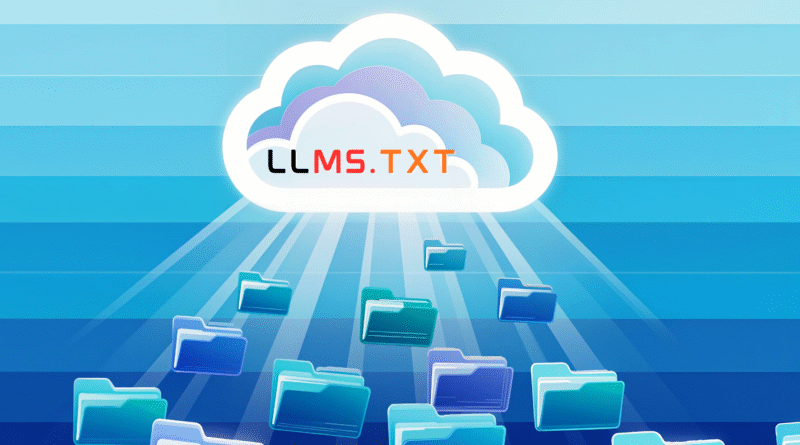LLMs.txt: The Emerging Web Standard for AI Crawling and Data Permission Control
As Large Language Models (LLMs) like OpenAI’s GPT, Google’s Gemini, and Anthropic’s Claude become integral to the modern internet, the boundary between public content and AI training data has grown increasingly blurred.
Today, websites are constantly being scanned, indexed, and ingested — not just by search engines but by AI systems training on massive web-scale datasets. This has raised pressing concerns about content ownership, attribution, and data consent.
To address this, the tech community is proposing a new standard: LLMs.txt — a robots.txt-inspired protocol designed specifically to manage how AI crawlers and model developers interact with web content.
1. Understanding LLMs.txt
What is LLMs.txt?
LLMs.txt is a machine-readable text file placed at the root of a domain (e.g., https://example.com/llms.txt). It defines permissions and restrictions for AI crawlers — determining what data can be used for training, inference, or citation by LLMs and AI systems.
The file allows publishers to control how their content contributes to AI datasets, similar to how robots.txt controls access for web crawlers like Googlebot or Bingbot.
Core Purpose
- Protect intellectual property and digital rights.
- Give website owners granular control over how AI models use their data.
- Promote ethical, transparent, and compliant AI data practices.
- Build a structured protocol for AI crawler behavior across the web.
2. How LLMs.txt Works
File Structure and Syntax
The structure of llms.txt mirrors the simplicity of robots.txt but adds AI-specific directives for modern model operations.
Here’s a typical configuration:
# LLMs.txt – Example
User-Agent: OpenAI
Allow: /articles/
Disallow: /premium-content/
Training: disallow
Inference: allow
Attribution: require
Commercial-Use: disallow
User-Agent: Anthropic
Allow: /
Training: allow
Attribution: optional
Key Directives Explained
| Directive | Purpose | Example Value | Description |
|---|---|---|---|
| User-Agent | Identifies the AI crawler or model name. | OpenAI, Anthropic, Google-DeepMind | Specifies which AI system the rule applies to. |
| Allow / Disallow | Grants or blocks access to directories or pages. | /public/, /private/ | Controls which site paths AI crawlers can access. |
| Training | Enables or blocks content usage in AI model training datasets. | allow / disallow | Protects data from unauthorized AI training. |
| Inference | Allows or denies models from using content during responses. | allow / disallow | Determines if data can be referenced in model answers. |
| Attribution | Requires that AI outputs cite or credit the source. | require / optional / none | Ensures creators receive recognition. |
| Commercial-Use | Specifies if content can be used in commercial AI products. | allow / disallow | Supports licensing and monetization control. |
How AI Crawlers Use It
- The AI crawler first requests the
https://example.com/llms.txtfile. - The crawler parses the directives specific to its
User-Agent. - Based on permissions, it determines whether content can be:
- Scraped for model training datasets.
- Indexed for reference or AI search.
- Used in responses (inference).
- Cited or attributed in outputs.
This process mirrors robots.txt, but focuses on AI data governance rather than search indexing.
3. Why LLMs.txt Is Important
A. Ethical Data Usage
The AI industry is under scrutiny for unauthorized data ingestion — scraping blogs, articles, and academic papers without consent. LLMs.txt creates a standardized, opt-out mechanism for web content owners.
B. Legal Compliance
Emerging regulations such as the EU AI Act, U.S. AI Bill of Rights, and Digital Copyright Directives demand explicit data consent and traceability. LLMs.txt supports these compliance efforts.
C. Transparency and Trust
By publishing data policies openly, AI companies and content creators can establish a trust framework, making AI ecosystems more accountable and auditable.
D. SEO and AI Discoverability
In the future, AI-driven search engines (like ChatGPT Search or Perplexity.ai) may use LLMs.txt signals to:
- Prefer websites that opt-in for AI referencing.
- Respect opt-out restrictions from sensitive domains.
- Provide source links and traffic back to publishers.
4. Comparison: LLMs.txt vs Robots.txt
| Feature | robots.txt | llms.txt |
|---|---|---|
| Purpose | Controls web indexing by search engines | Controls AI model data usage |
| Crawlers | Googlebot, Bingbot, etc. | GPTBot, ClaudeBot, GeminiCrawler, etc. |
| Focus | SEO visibility and crawl rate | Data consent, training rights, attribution |
| Legal Standing | De facto industry standard | Emerging protocol under discussion |
| Syntax | Allow / Disallow | + AI-specific directives (Training, Inference, Commercial-Use) |
| Adoption Stage | Mature and universal | Experimental and voluntary |
5. Technical Implementation Steps
Step 1: Create the File
- Use a plain text editor to create
llms.txt. - Place it in the root directory of your website (same level as
robots.txt).
Step 2: Define Access Rules
Include rules for known AI crawlers:
User-Agent: GPTBot
Training: disallow
Inference: allow
Attribution: require
Step 3: Publish and Test
- Host the file at
https://yourdomain.com/llms.txt. - Use server logs or header inspection tools to monitor AI crawler requests.
- Ensure compatibility with your existing
robots.txtdirectives.
Step 4: Periodically Update
As new AI crawlers emerge, update your llms.txt file to manage new agents and use-cases.
6. Current Adoption and Industry Discussion
While LLMs.txt isn’t yet standardized by W3C or ISO, it’s gaining attention across the AI and web communities.
- OpenAI’s GPTBot already respects
robots.txtrules. - Perplexity.ai and Common Crawl are experimenting with AI dataset transparency.
- Discussions on GitHub, Reddit, and ArXiv propose schema extensions and formal RFC drafts.
If adopted widely, it could evolve into a W3C-backed specification for AI data governance.
7. Benefits for Stakeholders
| Stakeholder | Benefit |
|---|---|
| Publishers | Protect original content from unapproved model training. |
| Developers | Gain a clear, standardized compliance mechanism. |
| Regulators | Simplify enforcement of AI data rights and consent laws. |
| SEO/Marketers | Control visibility across AI search and generative platforms. |
| AI Companies | Build public trust through transparent data sourcing. |
8. Limitations and Future Challenges
While promising, LLMs.txt faces certain limitations:
- Voluntary Compliance — There’s no enforcement layer; models must choose to honor it.
- Ambiguous Definitions — Differentiating “training” from “inference” can be technically complex.
- No Verification Mechanism — Lacks digital signatures or audit trails.
- Dynamic Content Issues — AI crawlers may still capture content rendered dynamically (e.g., via APIs).
- Fragmented Adoption — Standardization depends on cross-industry agreement.
However, future versions may integrate cryptographic verification, AI-meta headers, or JSON-based permission frameworks to address these concerns.
9. Future Evolution of AI Web Governance
LLMs.txt could be the foundation for a broader AI consent ecosystem, evolving alongside:
- AI-META Tags: HTML-based metadata for page-level permissions.
- AI-LICENSE.json: JSON schema for structured data usage licensing.
- Blockchain Registries: Immutable records for content consent verification.
- AI Crawl APIs: Secure, authenticated data sharing protocols.
Together, these could create a Consent-Aware AI Web — where data rights are as integral as accessibility and security.
FAQs on LLMs.txt
LLMs.txt is a proposed web standard designed to control how AI systems and Large Language Models (LLMs) such as ChatGPT, Gemini, or Claude can access and use website content. Similar to robots.txt, it provides machine-readable permissions for AI data training, inference, and attribution.
LLMs.txt was introduced to address growing concerns about unauthorized data scraping by AI models. It allows content owners to define clear permissions and protect intellectual property while enabling responsible AI development and compliance with emerging data laws.
While robots.txt governs web crawlers for search indexing, LLMs.txt specifically regulates AI crawlers and their access for training or referencing data. It introduces new directives such as Training, Inference, and Attribution to manage how LLMs use online content.
You should host the llms.txt file in the root directory of your website — for example, https://yourdomain.com/llms.txt. This ensures that AI crawlers can automatically detect and interpret your permissions before accessing your data.
Key directives include:
User-Agent: Identifies the AI crawler.
Allow / Disallow: Controls content accessibility.
Training: Allows or blocks data use for model training.
Inference: Governs whether AI models can reference content.
Attribution: Requires citation in AI responses.
Commercial-Use: Restricts commercial exploitation of data.
Currently, compliance is voluntary. However, as regulations such as the EU AI Act and U.S. data consent laws evolve, honoring LLMs.txt could become a legal requirement or industry standard for ethical AI development.
LLMs.txt allows publishers to control how AI search engines (like ChatGPT Search or Perplexity.ai) reference their content. By opting in, websites can gain citations and traffic from AI-generated answers. Conversely, disallowing access prevents unauthorized use of proprietary content.
Yes. You can deny access to all AI crawlers by using the following rule:User-Agent: * Disallow: /
This will prevent all registered AI agents from training on or referencing your content.
AI crawlers like OpenAI’s GPTBot, Anthropic’s ClaudeBot, and Common Crawl have started to honor robots.txt directives. LLMs.txt aims to extend this support specifically for AI-focused access control with more detailed and explicit permissions.
LLMs.txt is expected to evolve into a global AI data governance standard, possibly endorsed by W3C or major AI policy groups. Future versions may include JSON-based AI-usage metadata, digital signatures, and automated compliance verification for enhanced transparency.
Yes. By specifying Training: disallow or Commercial-Use: disallow, creators can restrict their data from being used in AI models or commercial applications without consent. This provides a lightweight but effective copyright control mechanism for online content.
At present, there’s no official validator, but web developers can use tools like cURL, Postman, or AI-crawler simulation scripts to test responses. Once standardized, expect open-source LLMs.txt validators and browser plugins to emerge.
Conclusion
LLMs.txt marks a crucial milestone in the evolution of the open web.
By extending the concept of robots.txt to AI models, it bridges the gap between content creators, AI developers, and data ethics — empowering website owners with real choice in how their information fuels AI innovation.
As the web transitions from being indexed by search to being understood by intelligence, protocols like LLMs.txt will become essential infrastructure — defining not just what AI can see, but what it’s allowed to learn.




